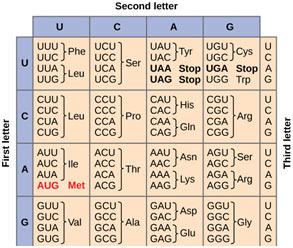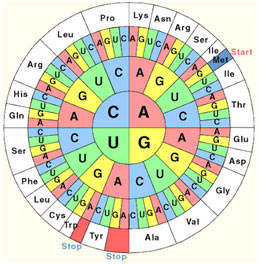Definition
“The genetic code is basically a sequence of three bases called a triplet code. Each three bases combination is known as codon”.
DNA must code for amino acids essential for proteins. This information is present in the sequence of nitrogenous bases of DNA and is transferred to mRNA.
Degeneracy
There are 64 possible codons but amino acids are only 20. So, more than one codon can specify the same amino acid. This characteristic of the codon is called degeneracy.
History of Genetic Code
It was postulated by George Gamov that a three-letter code must be used to encode 20 amino acids. The first actual codon was made by Marshall Nirenberg and Johann Matthaei in 1961. They used a cell-free system to translate a poly uracil RNA sequence (UUUUU…).
They found that codon UUU specified amino acid phenylalanine. Later, Har Gobind Khorana identified the rest of the code. Shortly after, Robert Holley identified tRNA as the adapter molecule.
Genome Expression
The gene sequence inscribed in DNA and RNA is composed of tri-nucleotide units. Overall, there are 43 = 64 different codon combinations.

Start/ Stop Codons
- Start codons:
Translation starts with a chain initiation codon. The most common start codon is AUG. it also codes for methionine. Other start codons are also used to start the translation.
- Stop codons:
The codon that terminates the translation is called the stop codon. In classical genetics, UAG, UGA, and UAA are called stop codons. Stop codons are also known as termination codons.
Degeneracy of the genetic code
Many codons are redundant. It means that two or more codons can code for the same amino acid. Degenerate codons may differ in their third positions. For example, both GAA and GAG code for the amino acid – glutamic acid.
- Four-fold degenerate
A codon is said to be four-fold degenerate if any nucleotide at its third position specifies the same amino acid.
- Two-fold degenerate
A codon is said to be two-fold degenerate if only two of four possible nucleotides at its third position specify the same amino acid. In two-fold degenerate codons, the equivalent third position nucleotides are always two purines (A / G) or two pyrimidines (C / T).
Degeneracy is essential in order to produce enough different codons to code for 20 amino acids and a stop codon. There are four bases. Therefore, triplet codons are required to produce at least 21 different codes.
Only two amino acids are specified by a single codon. One is the amino acid – methionine, by codon AUG and the other is tryptophan specified by UGG.
Reading Frame of Sequence
Codon is defined by the starting position. Let’s consider an example, there is a string of GGGAAACCC. If it is read from the first position, contains the codon GGG, AAA, CCC. If it is read from the second position, contains GGA, AAC.
If it is read from the third position, contains GAA and ACC. Therefore, every sequence can be read in three reading frames. But the actual frame is defined by the start codon.
Variations
Codons are universal in most organisms. But some variations are present in some organelles or species.
- Variations in genetic code are found in mitochondria.
- Mycoplasma translates UGA as tryptophan.
- In some species of the yeast candida, CUG codes for serine.

